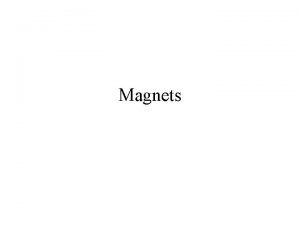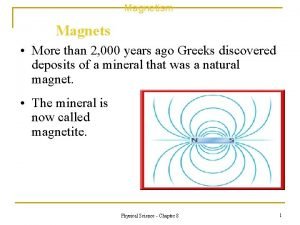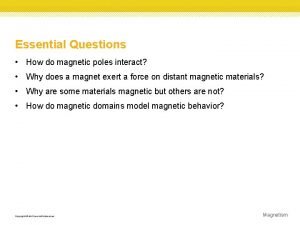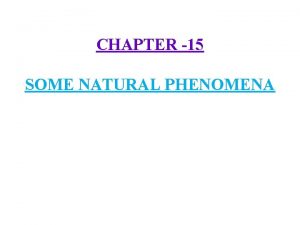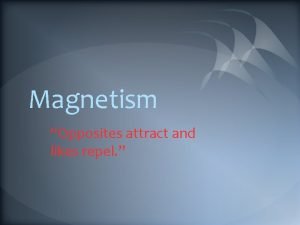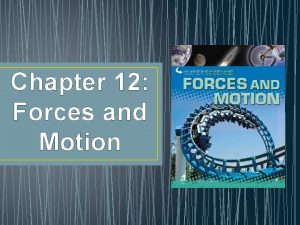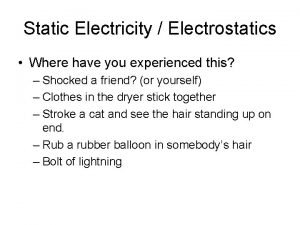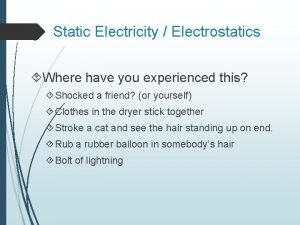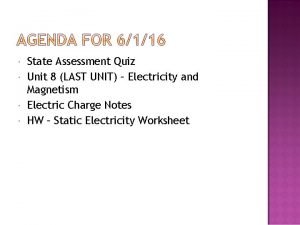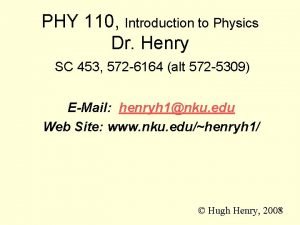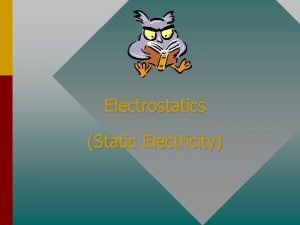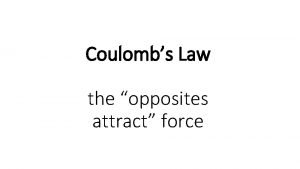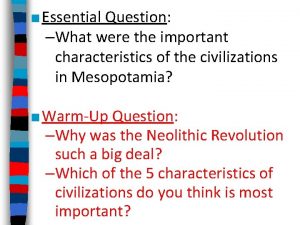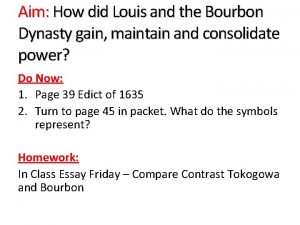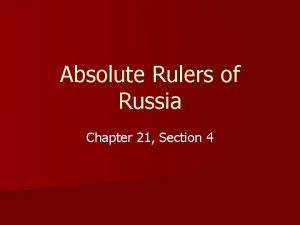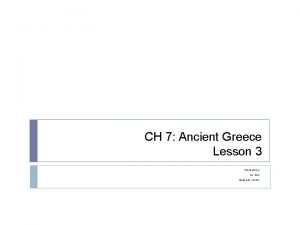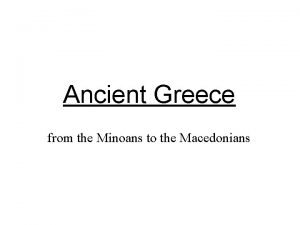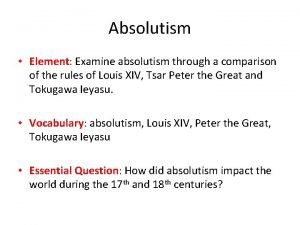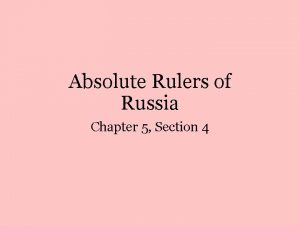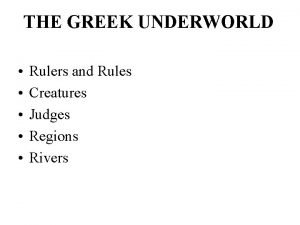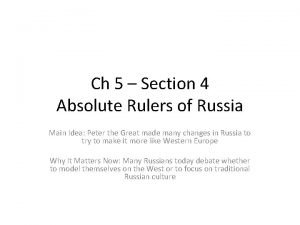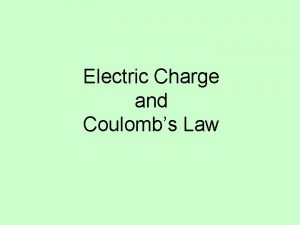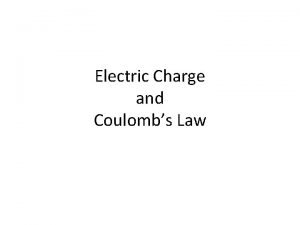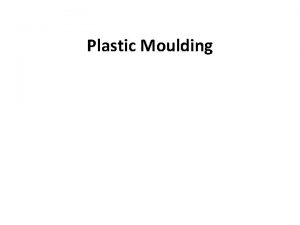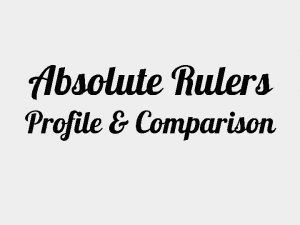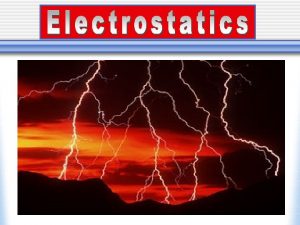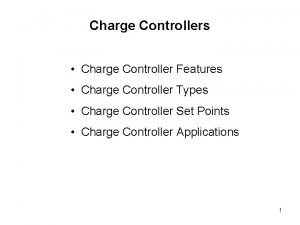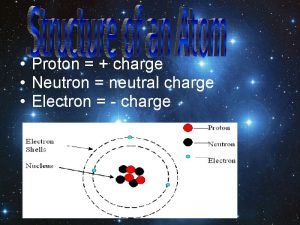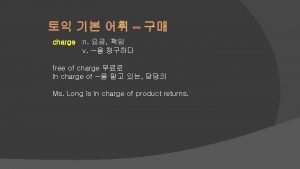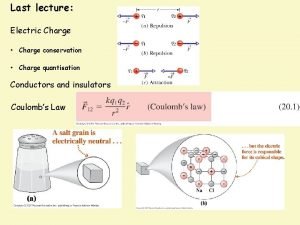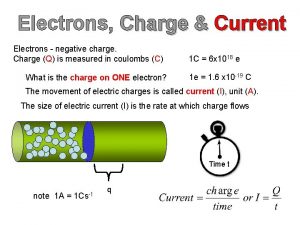Charge Two charged plastic rulers repel Two charged














































- Slides: 46

Charge Two charged plastic rulers repel Two charged glass rods repel Charged glass rod attracts charged plastic rule

Simple model of the atom

Polar Molecule Because it has opposite charges on different ends, it is called a "polar" molecule

Electroscope

Charging Electroscope by induction by conduction

To determine the sign of a given charge.

200 3 Q 22 The diagram below shows two metal spheres X and Y which are placed close to each other but not in contact. X is positively charged and Y is earthed. Which of the following is correct for Y? Charge on Y A Zero B Zero C Positive D Negative Electric potential on Y Zero Positive Zero

Analogy Gravitation Eletrostatics Force Coulomb’s Law Field Gauss’s Law Potential Energy

Coulomb’s Law

A +7. 7 C and a – 3. 5 C charge are placed 18. 5 cm apart. Where can the third charge be placed so that it experiences no net force? F 1 18. 5 7. 7 C x q C – 3. 5 C F 2 F 1 = F 2 x = 15. 4 cm

Find the net electrical force on particle 3. Force by particle 1, Force by particle 2, Net force = 1. 2 – 2. 7 = – 1. 5 N

A = + 65 C F 30 cm 60 cm P 30° B = + 50 C C = – 50 C Find the net electrical force on particle 3.

Electric Field Of A Point Charge

Electric Field Of A Point Charge

Electric Field Of A Dipole

Electric Field Of A Dipole

Electric Field Of A Dipole

Electric Field Of Uniform Charged Plate

Electric Field Of Hollow Conductor

A strong electric field exists in the vicinity of this "Faraday cage, " so strong that electrons are pulled off atoms of the air, and charge flows to (or from) the metal cage. Yet the person inside the cage is not affected.

Electric Field The electric field at a point is the force per unit charge place at that point.

2005 Q 23 The diagram below shows charges +q, +q and q which are fixed at points X, Y and Z of a circle respectively The resultant electric field at centre O of the circle is in the direction of A OY B OZ C YO D ZO Answer : B 2 +ve charges at X and Y produce resultant electric field in the OZ direction as the dirction of electric field of +ve charge is going out from the charge. The resultant electric field produced by the –ve charge is also in the OZ direction.

2002 Q 24 Which of the following is not true for an isolated charged conductor which is stationary and has an irregular shape? A B C D The charge density on the surface of the conductor is uniform. The charges of the conductor are found on its surface only. There is no electric field inside the conductor. There is no magnetic field around the conductor. Answer : A As the conductor has an irregular shape , it must has a sharp point which has a higher charge density. This is why we cannot stand under a tree when it is raining.


2004 Q 25 The diagram below shows an electron moving at constant speed through a region in a uniform electric field E. Electric field E Electron Which of the following is the most probable path of the electron? A C B Answer : C D

Electric Flux The electric flux through an area is the product of the area with the electric field perpendicular to it. = EA cos ϴ ϴ = angle between E and the nomal of the area

Gauss’s Law

A single point charge Q at the center of an imaginary sphere of radius r (our "gaussian surface"-that is, the closed surface we choose to use for applying Gauss's law in this case). Same as Coulomb’s Law

Cross sectional drawing of a thin spherical shell of radius ro carrying a net charge Q uniformly distributed. A 1 and A 2 represent two Gaussian surfaces we use to determine E.

Calculation of the electric field outside a large uniformly charged non-conducting plane surface s= charge per unit area

Calculation of E due to a very long line of charge. = charge per unit length

A solid sphere of uniform charge density. Magnitude of the electric field as a function of the distance r from the center of a uniformly charged solid sphere.

2004 24 A Gaussian surface encloses a charge of 2 C in vacuum. What is the electric flux through the surface? A C 1. 8 × 10– 17 Vm 1. 8 × 104 Vm B D 4. 4 × 10– 6 Vm 2. 3 × 105 Vm

Electric Potential Difference in potential energy between two points, Dividing by the charge q,

Electric Potential In A Uniform field Simplified to , V=E×l

Two parallel plates are charged to a voltage of 50 V. If the separation between the plates is 5. 0 cm, calculate the electric field between them, ignoring any fringing. 50 = E × 0. 05 E = 1000 V/m

Electric Potential Due to Point Charge The electric potential at a point in an electric field is the work done in moving unit charge from infinity to the point.

2005 Q 22 The electric field strength at point P at distance 20 cm from a point charge is 0. 40 V m– 1. The electric potential at point P is A 0. 02 V B 0. 08 V C 0. 20 V D 0. 80 V

Electric Potential Charge Conducting Sphere Outside the sphere at a distance x from the center Within the sphere of radius r

2001 Q 24 A charge of 2. 0 x 10– 8 C is given to an isolated solid spherical conductor of radius 10 cm. What is the electric potential at the centre of the sphere? A C 0. 9 k. V 18 k. V B D 1. 8 k. V infinity

2001 Q 25 Which of the following is true concerning the electric equipotential surface? A The charge density on the electric equipotential surface is uniform. B The electric field at any point on the electric equipotential surface is zero. C There is no potential difference between two electric equipotential surfaces which are closed to each other. D There is no work done in moving any charge on the electric equipotential surface. ANSWER : D W=Q x potential diffence.

Potential Energy The difference in Potential Energy between two points, U = QV

2000 Q 27 Two point charges, each of charge +Q, are placed at a distance 2 a from each other in a vacuum with permittivity o. When a particle of mass m and charge –q is released from rest from infinity, the particle moves along the direction PO as shown in the figure below. Direction of motion of charged particle What is the maximum velocity attained by the particle?

Power P = IV Derivation U = QV P = IV

Calculate the resistance of a 40 W automobile headlight designed for 12 V battery.

2002 Q 29 Which of the following uses the highest electrical power? A C B D
 What are plastic rulers made of
What are plastic rulers made of Which universal force can repel as well as attract
Which universal force can repel as well as attract Why do magnets repel
Why do magnets repel Why do magnets repel
Why do magnets repel Why do magnets repel
Why do magnets repel How do magnetic poles interact?
How do magnetic poles interact? Electron charge
Electron charge Repel
Repel Magnetism opposites attract
Magnetism opposites attract If an eagle and a bumblebee are traveling at 10m/s
If an eagle and a bumblebee are traveling at 10m/s Like charges attract or repel
Like charges attract or repel Like charges attract or repel
Like charges attract or repel Like charges attract or repel
Like charges attract or repel Like charges attract or repel
Like charges attract or repel Like charges attract or repel
Like charges attract or repel Opposites attract law
Opposites attract law Amazing magnets fishing magnet
Amazing magnets fishing magnet Difference between charge and electric charge
Difference between charge and electric charge Difference between charge and electric charge
Difference between charge and electric charge Sumerian rulers
Sumerian rulers How did louis xiv gain, consolidate, and maintain power?
How did louis xiv gain, consolidate, and maintain power? Absolute rulers of russia
Absolute rulers of russia How did persian rulers unite their vast empire?
How did persian rulers unite their vast empire? Seven squared football team
Seven squared football team The rulers of the minoans were ________.
The rulers of the minoans were ________. How did these three absolute rulers eliminate competition?
How did these three absolute rulers eliminate competition? Absolutis
Absolutis Absolute rulers of russia
Absolute rulers of russia My pencil is . . . . the books and the notebooks
My pencil is . . . . the books and the notebooks Chapter 5 section 4 absolute rulers of russia
Chapter 5 section 4 absolute rulers of russia In the prince machiavelli advises rulers to
In the prince machiavelli advises rulers to Ming rulers
Ming rulers Rules of the underworld
Rules of the underworld A ruling house or continuing family of rulers
A ruling house or continuing family of rulers Decline of the delhi sultanate
Decline of the delhi sultanate Helped overthrow the qin dynasty
Helped overthrow the qin dynasty European rulers denounced the french revolution because
European rulers denounced the french revolution because Tang song china
Tang song china How were european rulers guided by enlightenment thought
How were european rulers guided by enlightenment thought Absolute rulers of russia section 4
Absolute rulers of russia section 4 Rulers with almost absolute power
Rulers with almost absolute power Chapter 21 section 4 absolute rulers of russia
Chapter 21 section 4 absolute rulers of russia Two equally charged pith balls are 3 cm apart
Two equally charged pith balls are 3 cm apart N fundamental charges
N fundamental charges Two 8 gram equally charged balls are suspended on earth
Two 8 gram equally charged balls are suspended on earth Two main types of plastic
Two main types of plastic Two types of plastic
Two types of plastic



